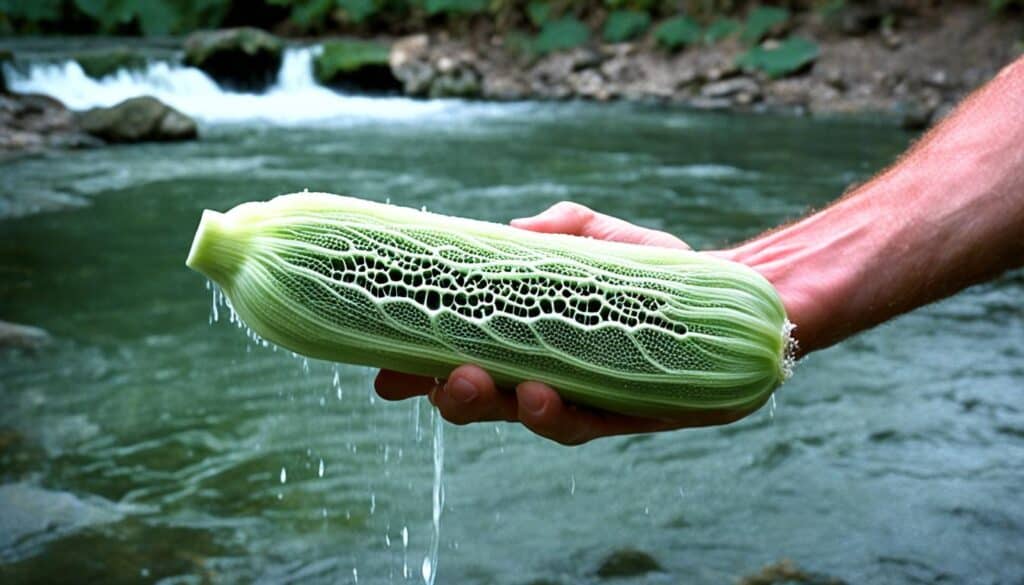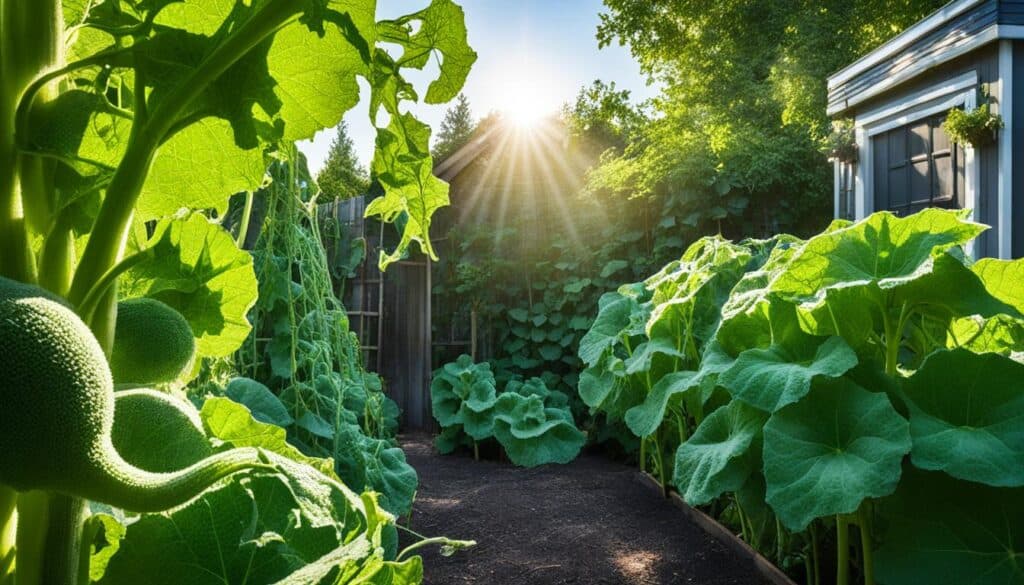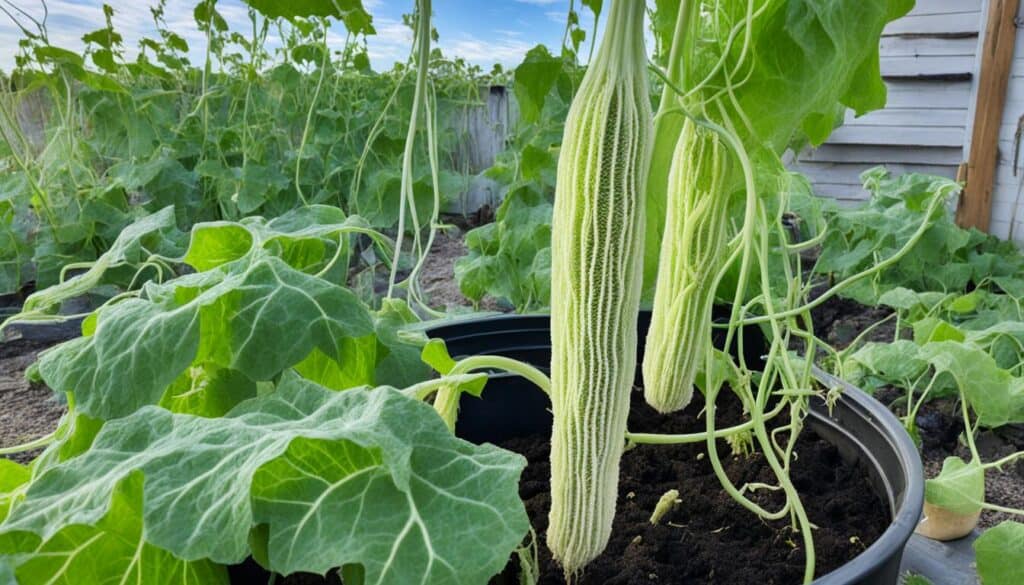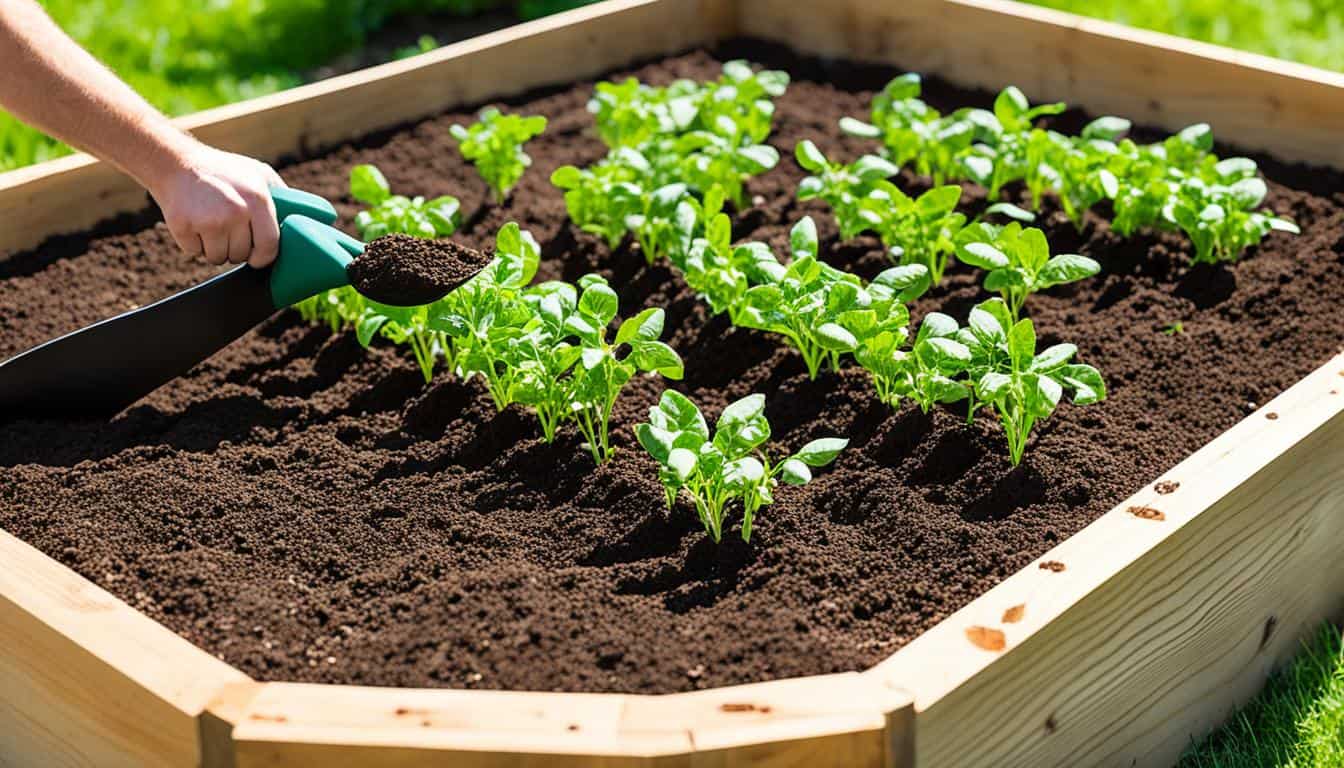Did you know that the luffa gourd, also known as sponge gourd or luffa cylindrica, can be transformed into a natural exfoliating sponge? This surprising fact reveals the incredible potential of this humble vegetable as a sustainable solution for skincare and beauty. In this guide, I will share everything you need to know about growing luffa cylindrica and harvesting your very own organic loofahs, taking a step towards eco-friendly beauty and sustainable skincare.
Key Takeaways:
- luffa cylindrica, also known as sponge gourd or loofah gourd, can be grown to produce natural exfoliating sponges
- growing your own luffa plants provides a sustainable and eco-friendly alternative for skincare
- by following this guide, you can harvest your own organic loofahs at home
- luffa cylindrica belongs to the gourd family and has tropical origins
- with proper care, luffa cylindrica can be successfully grown in the UK and other temperate regions
The Origin of Luffa Cylindrica
Luffa cylindrica, a vine-growing plant, belongs to the gourd family (Cucurbitaceae) and is closely related to watermelons, cucumbers, and pumpkins. Unlike sponges derived from ocean-dwelling animals, natural loofah sponges come from the fruits of the luffa plant. These plants have tropical origins but can be successfully grown in more temperate regions.
Growing Luffa Cylindrica
To grow luffa cylindrica, you will need luffa seeds, compost, small plant pots, a large clear plastic box with a lid (optional), large plant pots or grow bags, secateurs, twine and canes (optional), and a thermometer (optional).
- Start by sourcing luffa seeds, either from online retailers or local garden centers.
- In late March or early April, plant the seeds in small pots filled with compost and water them well.
- Germination occurs between 25-30°C and takes about 20 days.
- Once the seedlings have a few leaves and the risk of frost has passed, repot them in grow bags or large pots outdoors.
- Provide support for the vines by placing them against a wall or trellis and keep the compost moist while avoiding overwatering.
- Yellow flowers will appear, followed by green fruits.
- Leave the fruits to turn brown and dry out on the vine before harvesting them.
Optional Steps
- If you live in a cooler climate, you can use a large clear plastic box with a lid to create a mini greenhouse effect and maintain consistent temperatures for germination.
- You can use twine and canes to provide additional support to the growing vines, especially if you are growing them in larger pots or grow bags.
- A thermometer can help you monitor the temperature inside the plastic box or near the growing area to ensure optimal conditions for germination.
By following these steps and providing the necessary care, you can successfully grow luffa cylindrica and enjoy a bountiful harvest of fresh luffa fruits.
Harvesting Luffa Cylindrica
When it comes to luffa cylindrica, timing is everything. To ensure you enjoy the perfect loofah sponge, it’s crucial to wait for the fruits to ripen fully on the vine. The vibrant green exterior will gradually transform into a dry, brown color, indicating that the luffa is ready for harvest.
To harvest the luffa, simply use a pair of secateurs to gently cut the fruit from the vine. Be careful not to damage the surrounding vines or other mature fruits that are still ripening. Once you have the luffa in hand, it’s time to prepare it for use!
Preparing the Luffa Sponge
- Begin by removing the tough exterior skin of the luffa. Use your hands to peel away the dried skin, revealing the fibrous interior that makes up the loofah sponge. This process may take a bit of effort, but it’s worth it to access the rejuvenating properties of the sponge.
- After peeling the skin, you’ll notice small seeds inside the luffa. To remove them, simply shake the luffa vigorously. The seeds will fall out, leaving you with a seed-free sponge.
- Once the seeds are removed, it’s essential to wash the luffa thoroughly before using it for the first time. Rinse it under warm water, gently squeezing the sponge to ensure all dirt and debris are removed.
Now that your freshly harvested and cleaned luffa is ready to go, it’s time to put it to good use. Whether you’re looking for a natural exfoliating bath sponge or a tool to aid in kitchen cleaning, the luffa sponge has you covered.
For bath time, simply wet the luffa sponge and add your favorite soap or body wash. The natural fibers provide gentle exfoliation, leaving your skin feeling refreshed and rejuvenated. You can use the luffa sponge whole or cut it into smaller rounds or flat pads, depending on your preference.
In the kitchen, the loofah sponge is a versatile tool for washing dishes and scrubbing surfaces. Its natural texture helps to remove stubborn stains and grease, making it an ideal eco-friendly alternative to traditional sponges or scouring pads.
So, whether you’re stepping into the shower or tackling dirty dishes, the luffa sponge is here to make your life easier. Harvested from your own luffa cylindrica plants, this natural and sustainable sponge is both effective and environmentally friendly.
Growing Luffa Cylindrica in the UK
Although luffa plants have tropical origins, they can be successfully cultivated in the UK. Starting the seeds indoors in late March or early April is recommended for optimal growth. Germination requires consistent temperatures of 25-30°C and typically takes about 20 days. Once the seedlings are well-established and the risk of frost has passed, they can be transplanted outdoors. Luffa fruits are usually ready for harvest in mid-September.
When growing luffa cylindrica in the UK, it is important to consider the specific requirements for cultivating this tropical plant in a different climate. By following the right germination temperature and planting timeline, you can enjoy a successful harvest of organic loofah sponges right at home.
| Month | Activity |
|---|---|
| March – April | Start seeds indoors |
| April – May | Monitor germination temperature |
| May | Transplant seedlings outdoors |
| June – July | Provide vertical support for vines |
| September | Harvest luffa fruits |
By carefully timing your luffa cultivation in the UK, you can ensure that the plants have the best chance of thriving in the local climate. Starting indoors allows for a controlled environment, ensuring the optimal germination temperature is maintained for successful seedling development. Transplanting outdoors after the risk of frost has passed ensures that the plants are not exposed to cold temperatures that could hinder their growth.
Throughout the growing season, it is essential to monitor the progress of the luffa plants and provide necessary care, such as vertical support for the vines. This helps maximize sunlight exposure and fosters proper growth and development of the fruits.
“With proper timing and care, it’s absolutely possible to grow luffa cylindrica in the UK. Starting the seeds indoors and transplanting outside at the right time ensures a successful harvest of these unique vegetable sponges.”
- Start seeds indoors in late March or early April.
- Provide consistent germination temperatures of 25-30°C for about 20 days.
- Transplant seedlings outdoors after the risk of frost has passed.
- Support the vines vertically for optimal growth.
- Harvest luffa fruits in mid-September.
By following these guidelines, you can enjoy the unique experience of cultivating luffa cylindrica in the UK and harvest your very own organic loofah sponges.
Tips for Successful Luffa Cultivation
To maximize your chances of successful luffa cultivation, consider the following tips:
- Start indoors in cooler climates to prevent frost damage.
- Provide consistent temperatures of 25-30°C for germination.
- Transplant seedlings once the risk of frost has passed.
- Provide vertical support using a sturdy structure such as a wall or trellis.
- Ensure the plants receive as much sunlight as possible.
By starting your luffa plants indoors, you can protect them from potential frost damage that can occur in cooler climates. This will give them a head start and ensure their survival.
Luffa seeds require warm temperatures to germinate successfully. Keep them in a warm and stable environment between 25-30°C to encourage successful germination and healthy seedlings.
Once the risk of frost has passed and your luffa seedlings have grown strong roots, transplant them outdoors. This will allow them to acclimate to the natural environment and continue their growth.
Luffa plants are vigorous climbers and require strong vertical support to grow properly. Use a sturdy structure like a wall or trellis to provide stability for the vines as they grow and produce fruit.
Luffa plants thrive in full sunlight, so make sure they are planted in a location that receives ample sunlight throughout the day. This will ensure proper growth, flowering, and fruit production.
| Growing Conditions | Temperature Requirements | Vertical Support | Sunlight Exposure |
|---|---|---|---|
| Suitable for tropical and temperate regions | Germination: 25-30°C | Sturdy structure like a wall or trellis | Full sunlight |
| Can be grown indoors in cooler climates | Transplant after frost risk has passed | ||
Growing Luffa for Eating
While luffa cylindrica is most commonly grown for its fibrous interior to make loofah sponges, certain varieties can also be harvested and eaten when young. The flower buds, flowers, and very young fruit can be used in salads, stir-fries, soups, stews, and curries. These edible luffa varieties provide a unique addition to culinary dishes and can be harvested before fully maturing into sponges.
Culinary Uses of Edible Luffa Varieties
When harvested young, edible luffa varieties offer a delightful crunch and mild flavor to various dishes. Here are some culinary uses:
- Add thinly sliced young luffa fruit to refreshing salads for a crisp and light texture.
- Toss young luffa in stir-fries with an assortment of vegetables and proteins for added texture and flavor.
- Incorporate young luffa into soups and stews for a unique twist and added nutritional value.
- Include young luffa in curries to complement the spices and bring a fresh element to the dish.
Experiment with different cooking methods and seasonings to discover your favorite way to enjoy edible luffa.
Harvesting Young Luffa Fruit
To harvest young luffa fruit for culinary purposes, look for fruits that are still tender and not fully matured. Young luffas are typically harvested when they are about 6-8 inches long and have a smooth skin. Avoid luffas with tough or fibrous skin, as they are better suited for sponge production.
Using a sharp knife or scissors, carefully cut the young luffa fruit from the vine. Handle the fruit gently to prevent any damage. After harvesting, wash the fruit thoroughly to remove any dirt or debris.
Once cleaned, the young luffa can be prepared and cooked according to your chosen recipe. Enjoy the unique taste and texture of homegrown, freshly harvested luffa in your culinary creations.
Image:
Overcoming Challenges in Growing Luffa Cylindrica
Growing luffa cylindrica can present certain challenges that gardeners need to be aware of in order to ensure a successful harvest. From the long growing season to issues with transplant shock and potential pests and diseases, it’s important to understand how to overcome these obstacles and maximize your luffa cultivation efforts.
Prolonged Growing Season
Luffa cylindrica has a long growing season, which can range from 150 to 200 days depending on the specific climate and growing conditions. Patience and consistency are key when growing luffa, as it requires ample time to develop and mature properly.
Proper Plant Care
Providing optimal care for your luffa plants is essential for their growth and productivity. This includes regular watering to keep the soil moist but not waterlogged, as luffa plants are sensitive to both drought and excessive moisture. Additionally, regular fertilization with a balanced organic fertilizer can help promote healthy growth and fruit development.
Transplant Shock
When transplanting luffa seedlings from indoor pots to outdoor garden beds or containers, they may experience transplant shock. This can result in stunted growth or even plant death if not managed properly. To minimize transplant shock, ensure that the seedlings are properly hardened off by gradually exposing them to outdoor conditions over a period of several days. It’s also important to handle the seedlings with care and ensure that they are transplanted into well-prepared soil.
Pests and Diseases
Luffa plants can be susceptible to certain pests and diseases. Common pests that may affect luffa plants include cucumber beetles, aphids, squash bugs, and vine borers. Regular inspection of the plants and prompt action at the first sign of pests is crucial to prevent infestations from spreading. Additionally, luffa plants can be prone to diseases such as powdery mildew and blight. Proper plant spacing, good air circulation, and avoiding overhead watering can help reduce the risk of disease.
| Common Pests | Common Diseases |
|---|---|
| Cucumber beetles | Powdery mildew |
| Aphids | Blight |
| Squash bugs | |
| Vine borers |
With regular monitoring, early pest and disease detection, and appropriate treatment measures, you can minimize the impact of these challenges on your luffa plants, ensuring a successful harvest of healthy and abundant vegetable sponges.
The Journey to Sustainable Skincare
By growing luffa cylindrica and using its fibrous interior as a natural exfoliating sponge, you are taking a step towards sustainable skincare and eco-friendly beauty. Embracing organic skincare is not only beneficial for your skin but also for the environment. Conventional beauty products often contain synthetic ingredients that can harm both your health and the planet.
Organic skincare products, on the other hand, are made from natural ingredients that are grown without the use of harmful pesticides and chemicals. By choosing organic skincare, you are supporting sustainable farming practices and reducing your exposure to potentially toxic substances.
Eco-Friendly Beauty
In addition to using organic skincare products, there are many other eco-friendly beauty practices you can incorporate into your daily routine. Consider using reusable cotton rounds or washcloths instead of disposable cotton pads, and opt for refillable or solid beauty products to reduce packaging waste.
Another sustainable alternative is to make your own DIY beauty products using simple, natural ingredients. For example, you can create a homemade face mask using ingredients like honey, yogurt, and avocado. Not only is this better for the environment, but it also gives you control over what goes onto your skin, ensuring you avoid harmful chemicals.
The Impact of Sustainable Alternatives
Choosing sustainable alternatives goes beyond skincare and beauty. It’s a conscious effort to reduce our ecological footprint and protect the planet for future generations. By opting for organic skincare and eco-friendly beauty practices, you are contributing to the preservation of biodiversity, the reduction of water and air pollution, and the conservation of natural resources.
“Sustainability is not just about doing what’s right for the planet; it’s about embracing a holistic approach to beauty that considers our health, the environment, and the well-being of communities.” – Emma Green, Founder of Green Beauty Co.
As consumers, we have the power to drive change by supporting brands that prioritize ethical and sustainable practices. By demanding transparency and accountability from the beauty industry, we can encourage the development of more eco-friendly and socially responsible products.
Discovering Sustainable Skincare
Now is the perfect time to embark on the journey towards sustainable skincare. Explore the world of organic skincare, discover eco-friendly beauty practices, and make conscious choices that align with your values. Together, we can create a more sustainable future for both our skin and the planet.
Let’s embrace sustainable alternatives and make a positive impact on our well-being and the environment.
Conclusion
Growing luffa cylindrica offers a wonderful opportunity to cultivate your own organic loofah sponges, providing a sustainable and eco-friendly solution for your skincare and beauty needs. By taking the time and care to create the perfect growing conditions, you can enjoy the numerous benefits of using a natural exfoliator while also reducing your impact on the environment.
Embracing the journey of growing luffa cylindrica not only allows you to have a ready supply of organic loofahs at home but also enables you to join the movement towards sustainable skincare and eco-friendly beauty. By opting for natural alternatives like luffa cylindrica, you contribute to a more sustainable lifestyle and minimize your reliance on synthetic products.
So, why not embark on this exciting adventure of cultivating luffa cylindrica? With its remarkable ability to transform into a natural sponge, it’s an excellent choice for those seeking a more sustainable and eco-friendly approach to skincare. Start growing your own organic loofahs today, and experience the benefits of this versatile plant firsthand.










Leave a Reply